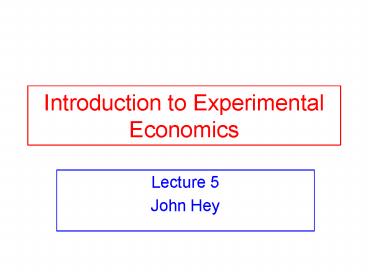Introduction to Experimental Economics - PowerPoint PPT Presentation
1 / 27
Title:
Introduction to Experimental Economics
Description:
Centipede Games ... I have therefore chosen centipede games. ... Centipede Game' Econometrica, 60, 803-836, of which you should read the non-technical part. ... – PowerPoint PPT presentation
Number of Views:131
Avg rating:3.0/5.0
Title: Introduction to Experimental Economics
1
Introduction to Experimental Economics
- Lecture 5
- John Hey
2
Game Theory
- Where do we begin?
- Equilibrium concepts.
- Nash Equilibrium.
- Backward Induction.
- Knowledge.
- Rationality.
- Assumptions about other players.
3
Game Theory
- Prisoners Dilemma.
- Dictator Game.
- Ultimatum Game.
- Coordination Games.
- Trust Games.
- Guessing games Beauty Contests.
- Centipede Games.
- .......
4
Game Theory site
- There is an excellent site at
- http//gametheory.tau.ac.il
- You need to register.
- You will need to enter the course number which is
1611 and your E-mail address. - The initial password is t235542Yu , but you will
need to select a new personalised password. - You will then play an introductory game.
5
Basic concepts
- The starting point is that of a Nash
Equilibrium... - ... In which everyone is doing what is best for
themselves given what everyone else is doing. - There may be one or more equilibria in either
pure or mixed strategies. - Are they plausible?
6
First simple game
7
Second simple game
8
Third simple game
9
Fourth simple game
10
Another game variant 1
11
Another game variant 2
12
Another game variant 3
13
Another game variant 4
14
Centipede Games
- As there have been literally thousands of
experiments on games of various types, I have to
be selective. - I have therefore chosen centipede games.
- Here you will find a link to Mckelvey R D and
Palfrey T R (1992), "An Experimental Study of the
Centipede Game" Econometrica, 60, 803-836, of
which you should read the non-technical part.
15
(No Transcript)
16
(No Transcript)
17
Predictions of Game Theory
- The first subject should Take.
- This conclusion can be reached by Backward
Induction - Starting at the final decision node, Player 2
will Take. - Given that, Player 1 should Take at the
penultimate node... - ...and so on.
18
Experimental Protocols
- Subjects played either the four or six move game.
- Groups of 20 (18) subjects who played 10 times
each against a different other player. - This guarantees that there should be no strategic
effects from one repetition to another... - ...while guaranteeing lots of observations.
19
Note what the authors say
- Thus it was common knowledge that no subject was
ever matched with another subject more than once.
In fact we used a rotating matching scheme which
insures that no player i ever plays against a
player who has previously played someone who has
played someone that i has already played.
(Further, for any positive integer n, the
sentence which replaces the phrase "who has
previously played someone who has played someone"
in the previous sentence with n copies of the
same phrase is also true.) In principle, this
matching scheme should eliminate potential
super-game or cooperative behavior, yet at the
same time allow us to obtain multiple
observations on each individual's behavior.
20
Notation fi is the proportion of games ending at
the ith terminal node.
21
(No Transcript)
22
(No Transcript)
23
Observations
- Data clearly inconsistent with the notion of the
game theoretic equilibrium Pr(T1) ? 1. - We note that Pr(Tt) pt increases with t.
- People getting nervous?
- We also note that as experience accrues pt
increases (for fixed t). - Notice that there are no strategic reasons for
this must be learning?
24
What McKelvey and Palfrey do
- Too sophisticated for this module.
- Essentially tries to explain the data with a
model in which - There exist selfish and altruistic subjects
- Subjects have to learn how many of each
- Optimal behaviour is a mixed strategy
- Errors in beliefs and in actions.
- It is instructive to read what they write...
25
(No Transcript)
26
(No Transcript)
27
Conclusions
- Raw game theoretic prediction based on selfish
individuals does not do too well (though they
might be approaching it). - Including a small number of altruists (and belief
of their existence) explains a lot of the
results. - Errors are important.































